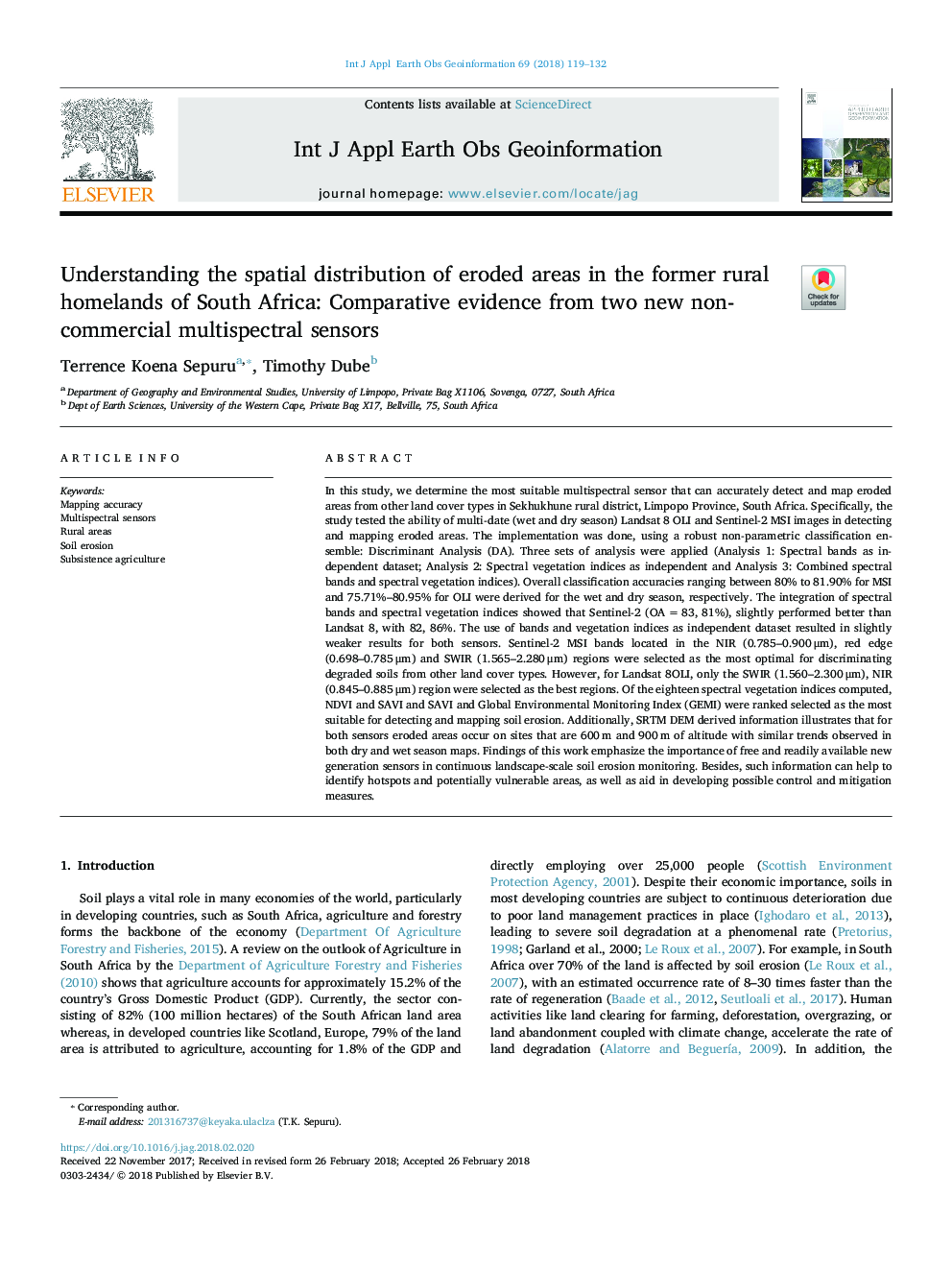| کد مقاله | کد نشریه | سال انتشار | مقاله انگلیسی | نسخه تمام متن |
|---|---|---|---|---|
| 8867875 | 1621788 | 2018 | 14 صفحه PDF | دانلود رایگان |
عنوان انگلیسی مقاله ISI
Understanding the spatial distribution of eroded areas in the former rural homelands of South Africa: Comparative evidence from two new non-commercial multispectral sensors
ترجمه فارسی عنوان
درک توزیع فضایی مناطق فرسوده در روستاهای سابق روستاهای آفریقای جنوبی: شواهد مقایسه ای از دو سنسور چند بعدی چند بعدی غیر تجاری
دانلود مقاله + سفارش ترجمه
دانلود مقاله ISI انگلیسی
رایگان برای ایرانیان
کلمات کلیدی
دقت نقشه برداری، سنسورهای چندضلعی مناطق روستایی، فرسایش خاک، کشاورزی،
موضوعات مرتبط
مهندسی و علوم پایه
علوم زمین و سیارات
کامپیوتر در علوم زمین
چکیده انگلیسی
In this study, we determine the most suitable multispectral sensor that can accurately detect and map eroded areas from other land cover types in Sekhukhune rural district, Limpopo Province, South Africa. Specifically, the study tested the ability of multi-date (wet and dry season) Landsat 8 OLI and Sentinel-2 MSI images in detecting and mapping eroded areas. The implementation was done, using a robust non-parametric classification ensemble: Discriminant Analysis (DA). Three sets of analysis were applied (Analysis 1: Spectral bands as independent dataset; Analysis 2: Spectral vegetation indices as independent and Analysis 3: Combined spectral bands and spectral vegetation indices). Overall classification accuracies ranging between 80% to 81.90% for MSI and 75.71%-80.95% for OLI were derived for the wet and dry season, respectively. The integration of spectral bands and spectral vegetation indices showed that Sentinel-2 (OAâ¯=â¯83, 81%), slightly performed better than Landsat 8, with 82, 86%. The use of bands and vegetation indices as independent dataset resulted in slightly weaker results for both sensors. Sentinel-2 MSI bands located in the NIR (0.785-0.900â¯Î¼m), red edge (0.698-0.785â¯Î¼m) and SWIR (1.565-2.280â¯Î¼m) regions were selected as the most optimal for discriminating degraded soils from other land cover types. However, for Landsat 8OLI, only the SWIR (1.560-2.300â¯Î¼m), NIR (0.845-0.885â¯Î¼m) region were selected as the best regions. Of the eighteen spectral vegetation indices computed, NDVI and SAVI and SAVI and Global Environmental Monitoring Index (GEMI) were ranked selected as the most suitable for detecting and mapping soil erosion. Additionally, SRTM DEM derived information illustrates that for both sensors eroded areas occur on sites that are 600â¯m and 900â¯m of altitude with similar trends observed in both dry and wet season maps. Findings of this work emphasize the importance of free and readily available new generation sensors in continuous landscape-scale soil erosion monitoring. Besides, such information can help to identify hotspots and potentially vulnerable areas, as well as aid in developing possible control and mitigation measures.
ناشر
Database: Elsevier - ScienceDirect (ساینس دایرکت)
Journal: International Journal of Applied Earth Observation and Geoinformation - Volume 69, July 2018, Pages 119-132
Journal: International Journal of Applied Earth Observation and Geoinformation - Volume 69, July 2018, Pages 119-132
نویسندگان
Terrence Koena Sepuru, Timothy Dube,
